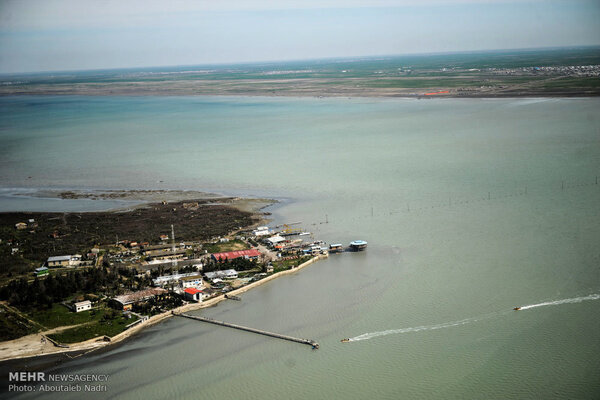Two main enclosed water bodies shrinking

TEHRAN – Gorgan Bay and Lake Urmia, the two main enclosed water bodies in the country, are declining to the extent that they will possibly dry up, Ali Soltanpour, director of hydrography and tidal affairs of the National Cartographic Center, has said.
Referring to the level of enclosed waters such as Lake Urmia and the Caspian Sea, he stated that in open waters, periodic changes (decrease and increase of water volume) are low and about 2 mm, which is due to rising water that is caused by global warming and the melting of ice.
But lakes that are not connected to open waters are affected by local climate change; therefore, if the rainfall in their catchment area decreases and drought and uncontrolled water withdrawal increases, the lake will dry up, the main example of which is Lake Urmia and Gorgan Bay.
The level of the lake has increased significantly in the early 1990s so that in 1995, it reached 1278.5 meters and many urban and coastal infrastructures were threatened.
Studies conducted in 2020 and 2021 show that the Caspian Sea lost 25 cm of water level. After this time, the water level of Lake Urmia gradually dropped due to reduced rainfall and water entering the lake, so that during 3 years, the lake level decreases by about one meter, he added.
According to Soltanpour, since 1998, the lake continued to shrink more rapidly and for 4 consecutive years, the level reduced by another 3.5 meters reaching 1274 meters in 2002.
In 2017, the level even declined to 1271 meters. However, increased rainfall caused the lake level to rise by more than one meter in only several months and exceed 1272 meters.
In the summer and the first two months of autumn this year, the lake’s level faced a decrease of 30 to 35 cm compared to the same time last year.
“Part of this situation is due to climate change, in addition to low rainfall, but the excessive withdrawal of water is sometimes irreversible. An example is the uncontrolled abstraction of water from underground aquifers. The groundwater is removed from these reservoirs in such a way that even if it rains, the reservoir loses its original capacity and will not be sufficiently filled,” he explained.
Emphasizing that the Caspian Sea water level has been decreasing for 16 years, he noted that some 80 percent of its water is supplied through the Volga River and when the Caspian water inflow decreases, the Caspian Sea level also drops.
In recent years, it has been said that the decrease in rainfall in the Volga has reduced the Caspian Sea water level, but it is possible that water withdrawal in the northern Caspian Sea has been effective in reducing the sea level.
Studies conducted in 2020 and 2021 show that the Caspian Sea loses 25 cm of water level.
In addition, the Gulf of Gorgan is also affected by these conditions, because this bay is connected to the Caspian Sea by a strait, and will soon dry up if the trend continues, he lamented.
Valuable ecological complex
Over 27 percent of the 400 square kilometers of Gorgan Bay - the largest gulf in the Caspian Sea - has dried up in recent years, according to the National Cartographic Center.
Covering an area of about 400 square kilometers, the Gulf of Gorgan also known as Gorgan Bay is located at the south-eastern shore of the Caspian Sea near the cities of Behshahr, Gorgan, and Sari and is separated from the main water body by the Miankaleh peninsula and extends until the Ashuradeh peninsula.
Gorgan Bay was designated as a Ramsar site (defined by the Ramsar Convention for the conservation and sustainable use of wetlands, recognizing the fundamental ecological functions of wetlands and their economic, cultural, scientific, and recreational value) along with Miankaleh Wetland.
The bay and its surrounding area are recognized as a valuable ecological complex in the world which had a direct impact on the livelihood of local communities in addition to conserving the marine life cycle.
Ashuradeh Island, which hosts a variety of native and migratory birds throughout the year, was also introduced and registered as one of the world's first biosphere zones in 1975.
FB/MG
